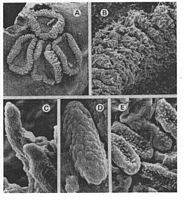|
 Unguiculariopsis triregia Unguiculariopsis triregia
BiostatusPresent in region - Indigenous. Non endemic
Images (click to enlarge)
Caption: Fig. 3: Unguiculariopsis triregia (CHR, holotype). - (A) Group of apothecia (x 70). - (B)
Outer hairs of exciple cells (x 700). - (C) Outer hairs of exciple cells (x 7100). - (D)
Ascospore (x 12 000). - (E) Ascospores (x 7000) |
Article: Kondratjuk, S.Y.; Galloway, D.J. (1995). Two new lichenicolous fungi from Lobaria and Sticta (Stictaceae). Flechten Follmann. Contributions to Lichenology in Honour of Gerhard Follmann Daniels, F.J.A.; Schulz, M.; Peine, J. (eds.) 255-261 Cologne: Geobotanical and Phytotaxonomical Study Group, Bot.
Description: Lichenicolous fungus, parasymbiontic on the thallus of Sticta squamata, producing brown
ascomata on unchanged host thalli. Ascomata apothecia, immersed only in the beginning,
than conspicuously superficial and sessile, to 560 - 670 µm diam., brown to dark or reddish
brown, mainly arising in groups of 3 - 4 or seldom singly. Ectal exciple rugose to fissured (=
splitting), with irregular hemispherical or elongated formations, (41.8-) 50.1 - 55.7 (-83.5)
µm diam. or width, brown, textura globulosa, cells brown, unequally thickened walls, ca. 5.5
- 9.0 µm diam., outer hairs well distinct at the top of some subglobose hyaline cells seen; up
to 3 - 5 (-9) µm long; medullary exciple consisting of groups of hyphae. Hymenium (54.0-)
63.0 - 72.5 µm high, hyaline or slightly yellowish to yellowish-brownish. Epiphymenium
much darker than hymenium, reddish brown to dark brown, 18.0 - 20.0 µm tall. Paraphyses
forming a rough surface to hymenium, to 2.5 - 3.5 µm in diam. at base, slightly or markedly
thickened up to 3.5 - 4.5 µm and conspicuously darkish at apices; very often agglutinated at
the tops in aggregation 3-5. Subhymenium slightly yellowish to yellowish-brownish, up to
90.5 (-108.5) µm thick. Asci narrowly cylindrical evenly thin at apex, 52.0 - 54.0 x 5.0 - 5.5
µm, Lugol I-. Ascospores hyaline, narrow-ellipsoid, 1-celled, smooth (or with slightly
verrucose surface, see SEM photos), 8.0 - 9.0 x 2.5 - 3.0 µm: fig. 3.
Notes: Unguiculariopsis triregia is most closely related to the recently described U. ahtii
HAWSKW., GALLOW. et KONDR. and the more common U. thallophila (P. KARST.)
ZHUANG. It differs, however, from both in having apothecia arising in groups up to 4 (in U.
thallophila and U. ahtii they are solitary), in having a more differentiated and darker
epithecium and thickened, agglutinated Paraphyses at the tops (in contrast, no differentiated
epithecium is found in U. thallophila, and slightly darker, unthickened Paraphyses are seen at
the tops in U. ahtii). Moreover, U. triregia differs from U. thallophila in the much larger
apothecia (see above, 200 - 400 µm in U. thallophila), much longer and narrower asci (see
above, 35 - 40 x 6 - 10 µm in U. thallophila, HAWKSWORTH [1980]). U. triregia differs
from U. ahtii in having well distinct outer hairs at the tops of some exciple cells (see above, ±
indistinct hyaline cells in U. ahtii), in having a much darker and thicker epihymenium
(orange-brown, 9.0 - 12.5 µm tall in U. ahtii), and in having smaller and wider ascospores (9
- 12.5 x 1.5 - 2.0 µm in U. ahtii, cf. KONDRATYUK et al. 1994).
Unguiculariopsis triregia differs from U. cribriformis (NORM.) ALSTRUP et HAWSKW. in
ascospore shape (globose, 5.0 - 5.5 [-6.0] µm diam.) and different hosts (U. cribriformis:
Pertusaria [ALSTRUP and HAWKSWORTH 1989]). U. triregia as well as U. ahtii, U.
cribriformis, and U. thallophila differ from all known species of Skyttea by having superficial
apothecia at maturity, with asci having a thick homogeneous wall without distinct apical cap,
globose excipular cells as well as by the absence of a greenish pigmentation of the exciple
and hairs. U. triregia is the fifth known lichenicolous species of this mainly fungicolous
genus.
|